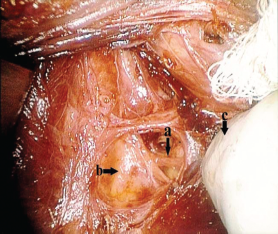What are the electrophysiological parameters of the nonrecurrent laryngeal nerve (NRLN), and how efficient is intraoperative nerve monitoring (IONM) for successful NRLN identification?
Bottom line
IONM is highly effective in NRLN identification. Right vagus nerve latency in the NRLN group was found to be significantly shorter than in the RLN group.
Explore This Issue
September 2017Background: The NRLN is a common anatomic variation of the right recurrent laryngeal nerve (RLN), which has been associated with an increased risk of injury during thyroid and parathyroid surgery. Previous reports suggest that the NRLN may be under-recognized and under-reported, and paresis and paralysis rates may be 10 times higher than the typical RLN. International neural monitoring guidelines call for routine and systematic use of nerve-stimulating equipment in RLN dissection, but there are very limited published data on the value of nerve monitoring for NRLN identification.
Study design: Retrospective database analysis of 15 NRLNs in a total 682 laryngeal nerves from a single surgeon at a tertiary care center between January 2012 and December 2015.
Setting: Tulane University Health Sciences Center, New Orleans.

Intraoperative view of a right nonrecurrent laryngeal nerve as captured during right thyroidectomy in one of our cases. (A) Right nonrecurrent laryngeal nerve. (B) Right common carotid artery. (C) Retracted right thyroid lobe.
Credit: © The American Laryngological, Rhinological and Otological Society, Inc.
Synopsis: Fifteen NRLNs were identified; all were right sided. Final diagnosis after surgical pathology was malignancy in seven of 15 cases (47%) and a benign disease in eight of 15 cases (53%). Stimulation of the NRLN was performed using 1 mA. Stimulation threshold for the right vagus nerve was 3 mA. The mean initial NRLN amplitude was 1010.5 µV ± 491.59 µV, with a range of 218 to 1,805 µV. The mean final NRLN amplitude was 859.31 µV ± 492.08 µV, with a range of 200 to 1,600 µV. The mean initial amplitudes of the right NRLN, right RLN, right vagus nerve, and both RLNs were compared using analysis of variance and found to be statistically significant. The mean initial NRLN latency was 1.06 ± 0.25 ms, with a range of 0.6 to 1.6 ms. The mean final NRLN latency was 1.09 ± 0.26 ms, with a range of 0.6 to 1.7 ms. Comparison of NRLN, right RLN, and left RLN latencies was significant. The latency associated with right vagus nerve stimulation in the NRLN group when compared with that of RLN group was significantly shorter. Limitations included limited ability to extrapolate to a larger patient population due to a small number of NRLN cases from a single surgeon.